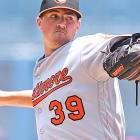2017 Fantasy Baseball draft strategy: One tweak could send Kevin Gausman soaring
If you're going to avoid investing in the early-round starting pitchers, Chris Towers has some options for you, including would-be Orioles ace Kevin Gausman.

My hunt for potential aces began in a pretty obvious place, with Cardinals fireballer Carlos Martinez. Martinez isn’t being drafted like an ace, but he’s also hardly being ignored, going off the board as he is at the start of the seventh round, No. 73 overall at FantasyPros.com.
If you want to invest in a pitcher with ace upside who is also a bit more of a sure thing, he’s a fine place to start, and has more upside than nearly anyone being drafted near him.
The rest of the series will look a bit deeper, and we’ll start with a pitcher who has had ace upside for years: Kevin Gausman. Gausman started showing signs of figuring things out in 2016, sporting a 3.61 ERA in 179 2/3 innings, by far his best season in the majors. He sported strikeout and walk rates better than the league average, and would have been even better if not for an over-inflated home run rate.
Gausman took a big step forward in the second half of the season, bumping his strikeout rate from 22.1 percent to 23.8, with his ERA dropping from 4.15 to 3.10. What changed? For Gausman, it may be as simple as this: He started throwing his best pitch a lot more.
For most pitchers, a fastball that averaged 95.9 miles per hour last season would be the headline, and that is what you notice first with Gausman. However, he gave up 19 homers on his four seamer, a pitch opposing hitters hit .265 on with a .174 ISO against. The pitch wasn’t necessarily a detriment, but it was hardly the weapon it might seem given that it was the eighth-hardest fastball among starters last season.
Gausman’s best pitch has always been his splitter. Last season, opposing batters hit just .196 against the pitch with a .095 ISO. He threw the pitch 19.2 percent of the time in 2016, just a touch higher than his past rates, safely making it his second pitch. However, for the season as a whole, he still threw it about one-third as often as his fastball, which hardly seems an ideal mix, given his results.
However, Gausman started throwing it more often as the season went on, reaching 22.4 percent after the All-star break. His change wasn’t as significant as that of Matt Shoemaker, who basically relied on his splitter as his primary pitch for much of the season, but maybe it should have been. Among pitchers who threw at least 200 splitters in 2016, Gausman had the highest whiff per swing rate, at 45.9 percent. Toss in a foul/swing rate of 27.4 percent, and opposing hitters put the ball in play just 26.7 percent of the time they swung at it.
Overall, Gausman induced a whiff 24.2 percent of the time he threw his splitter, the highest in baseball by a pretty healthy margin. However, four pitchers threw their splitters more often than Gausman, despite none really getting close to matching his success with the pitch.
Far be it for me, an out of shape sportswriter who might not be able to hit 60 MPH with a running start, to tell a finely tuned athlete how to go about his job. However, Gausman has what might be the best splitter in the game, and he saw the best sustained results of his career coincide with an increase in his usage of the pitch. Sometimes, the most obvious answer isn’t the correct one, but it feels like a thread Gausman should pull.
The splitter is typically considered a secondary pitch, but Shoemaker and Masahiro Tanaka have shown you can get away with using it essentially as a primary offering, and I would like to see Gausman try it out. He already showed signs of inching that way in the second half last season, and the next great leap forward for the 26-year-old could be this way.
With an ADP in the 12th round, Gausman’s ceiling could be well worth gambling on. He’s going in the same range as the likes of Dallas Keuchel and Matt Harvey, whose obstacles to ace-dom might be tougher than Gausman’s to overcome.


















